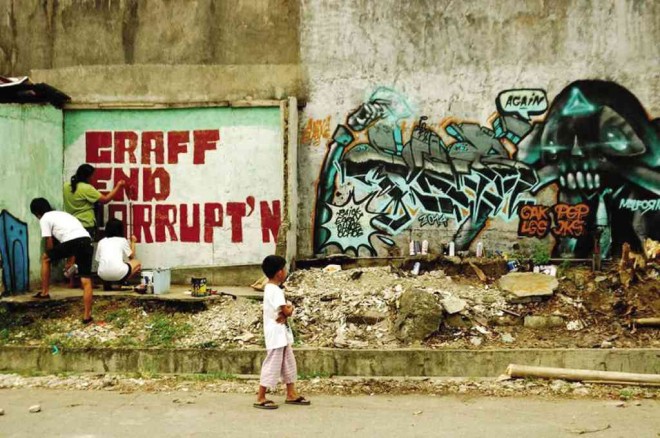‘Antigraft’ artists daub empty wall

GRAFFITI and street artists in Laguna daub an empty wall in Los Baños, Laguna, to protest corruption in the government. BENJIE VILLARUEL/CONTRIBUTOR
With a message loud and clear, an empty wall smeared with stylized calligraphy and grotesque images has become a vehicle to express what young minds may think of their government.
A group of young graffiti writers and street artists based in Los Baños started a campaign they called “Graff End Corruption”—and no, it wasn’t a grammatical blunder nor a misspelling.
“It’s just funny how people immediately called our attention to the spelling of “graff.” It’s just a word play (for graft and corruption) and graff is (a term used for) graffiti,” said a 22-year-old University of the Philippines Los Baños (UPLB) student, who wanted to be referred only by his tag, Noms.
As a subculture made popular in New York City, graffiti artists who use spray paints to mark their identities in a public space often use tags to remain anonymous.
Noms is a member of LB Connection, a graffiti artists’ crew or group based in the university town.
Article continues after this advertisementPolitical undertones
Article continues after this advertisementOn Sunday, nine people daubed an empty façade of a student dormitory along F.O. Santos street in Barangay (village) Batong Malake in this town.
The “sesh” (session) that ran from 11 a.m. to 3 p.m. was organized by Kulturang Ugnayan ng Kabataan Alay sa Bayan (Kulayan), an alliance of UPLB-based activist and cultural groups founded in 2008.
Without funding support, Kulayan chair and UPLB student Third Alub said the paint came as pledges from graffiti crews and individuals, while others were “scavenged from junk.”
“We tried soliciting from local hardware stores but they wouldn’t give us fresh paints, so we had to look for the used ones from their trash,” Alub said.
The graffiti, measuring six-meter wide and three-meter high, was an image of a misshapen skull. On one side of the wall was a spray-painted face of President Aquino and on the other was the text: Graff End Corruption. Then there was the word “NVR” (read as “never”) and a smaller image of a thought balloon with the word “again” inside.
But not all participants in Sunday’s sesh were political activists.
In fact, graffiti normally carries no political undertones but is purely a visual expression.
In this case, however, even if they came from different groups or “crews,” they all just agreed to a unifying concept of anticorruption, said Noms.
“The skull was a depiction of something corporate. ‘NVR’ was a tag (of one of the artists) but it could also mean ‘never again’ would we submit to corruption,” said one of the artists who introduced himself only as Bato.
Bato, 24, from Quezon City, is a member of another crew called Pilipinas Street Plan. Street painting since 2007, Bato, who also does gallery works, said it was his first time to work on something “political.”
“To be honest, I never wanted to do something political because I do not want to be bound (by that theme). Although I agree with this one anyway so it’s OK plus I’ve met new artists so the experience was fun,” he said.
Fresh approach
Kulayan said it was just the first of what would be a series of “antipork” graffiti works in Southern Tagalog.
“A week from now would (also) be the first anniversary of the Million People March so we thought this would be our way of showing our support to the cause,” Alub said.
The Million People March was a protest rally initially organized through social media. On Aug. 26, 2013, thousands from various sectors joined the rally simultaneously held in Manila and in key cities across the Philippines to call for the abolition of the Priority Development Assistance Fund or the “pork barrel.”
Alub said the use of graffiti is “a fresh approach” to political protests, at least in Laguna.
Comparing their work to those of “hard-core” activists, whose wall spray paintings were explicit political messages and were done hastily, theirs were aesthetically done and stylized, as Alub and Noms explained.
So far, in this town, it was one of the few wall graffiti in an open public space. Another was the 80 x 10-foot dolphin mural, done in 2010 by marine mammal expedition photographer and dolphin advocate Guerrero “AG” Saño on a façade of a school building, also in the same village.
“As they say, graffiti is a legal crime. Some may call it vandalism and we’re ready for those kinds of feedback,” Noms said. “But what matters more is to be able to catch your audience’s attention even for just a split second,” he said.